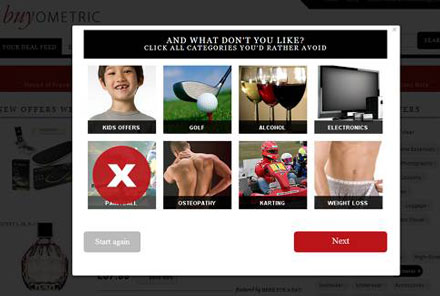By: Hannah Foley
3 Keys To Ensuring Subscribers Love Your Emails
As marketers we spend significant resources creating compelling content, crafting beautiful emails and coming up with smart subject lines so our customers love receiving our emails. Right? Practice these three keys to retain and engage your subscribers with emails they love.
1. Give the People what they want!
It is easy to get caught up in pushing your agenda instead of focusing on what our customer wants. You want to get your subscribers to content tailored for them quickly and then continue to solicit feedback you can act on to improve. Set up a preference center to help segment your list and get content and the frequ ency of emails right for each user. Ask individual subscribers what they want and make it fun. Set it up so the user gets to choose items from a menu like this example frostm UK’s online deal aggregator Buyometric.
ency of emails right for each user. Ask individual subscribers what they want and make it fun. Set it up so the user gets to choose items from a menu like this example frostm UK’s online deal aggregator Buyometric.
We believe in zero clutter. No new offers that match your requirements = no email.
Preference centers can also make the unsubscribe process more elegant and possibly even get a user to down-subscribe rather than completely cutting off your emails. Either way, you want the process to be clear and easy for a user so you don’t jeopardize their connection to the brand. Read here for Email On Acid’s in-depth take. And then check out Hubspot’s excellent quick tips on customizing your email preference center.
2. A subscriber’s behavior is a preference gold mine
As a subscriber interacts with your emails and website (and other channels if you’re really advanced) they are giving you clues to what they are interested in. Look at their behavior and pick up on trends that can be used to understand their preferences. Say you’re a clothing retailer, and you can that certain subscribers always click on the “women’s” nav button at the top of your email, chances are they will prefer emails about women’s clothing. What have they purchased? What did they click on in your welcome email? When a trend develops, an opportunity to segment that user to women’s clothing segment emerges. Then periodically check in with customers with a campaign asking if they are still enjoying your email content, but more on that later.
Behaviors including opens, clicks, unsubscribes are standard measures of email engagement. At a basic level, if someone unsubscribes from your emails, they aren’t liking them for some reason. If they clicked on the email, they found the content compelling. If a subscriber opens your email, they recognize your brand and were interested by the subject line, however, a word of caution on open rate as it can be an unreliable measure. There are a few things at play here. An open is counted when images render a large percentage of your customers may have image blocking enabled. On the other hand, a customer flipping through emails on a phone may open an email for a fraction of a second just because it was the next one in line and then delete – if images render, it counts as an open. This metric should be looked at in the context of other measures that are more reliable for indicating engagement like click throughs and conversions.
3. Show you care and then be a good listener
 Opens, clicks, conversions and unsubscribes are in their own ways, measurements of how much people like your emails but how about just asking? Make it simple at first: did you like this offer? Was this content helpful? To start, give them a simple choice – thumbs up or down? Try this email sentiment widget builder to ask about your emails.
Opens, clicks, conversions and unsubscribes are in their own ways, measurements of how much people like your emails but how about just asking? Make it simple at first: did you like this offer? Was this content helpful? To start, give them a simple choice – thumbs up or down? Try this email sentiment widget builder to ask about your emails.
Next you could ask gently if they want to elaborate. Maybe a “tell us more” drop down opens to a survey question or an open field you could give them the opportunity to “let our VP of Marketing know what you think” is enticing and feels worthwhile to the user. Simple measures like this let your users know you are listening.
Before asking, it is important to understand that asking the question is not enough. You have to start small so you can be prepared to react accordingly to the feedback you receive. If you offer a preference (don’t offer the choice of five different email types if you only have the capacity to handle three email types to start. Set expectations by framing the request in the right way – We’re looking at new content to help you – what interests you most? Or what would you like to see in the future?
It pays to understand what your audience wants to hear from you. If you don’t, customers will unsubscribe or possibly worse, disengage and grow to resent your brand. Above all, remember be relevant to each of your segments and always answer the question “what’s in it for them?”